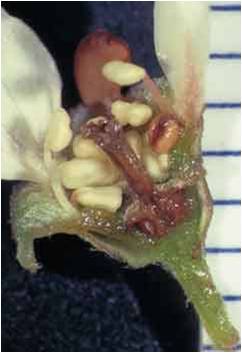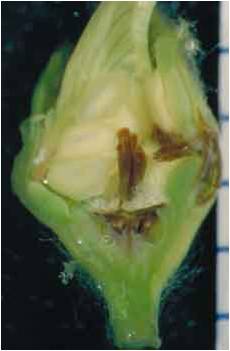Saskatoon Frost Tolerance and Injury Symptoms
The early spring combined with alternating warm temperatures one week and cool temperatures (with frost) the next, has resulted in staggered development of leaf and flower buds for many fruit trees, including saskatoons. As of the week of April 16 most saskatoon orchards were still in green-tip/green bud stage, so their tolerance to freezing temperatures is still quite good as the sensitive leaf and flower tissues are still protected somewhat by the bud.
Saskatoon Flower Bud Development Stages
Silver tip stage occurs just after dormancy and the brown buds have cracked open and are starting to fall off. The hairs beneath the bud are quite numerous and appear silver in colour. Green bud stage (or green tip) is when the flower cluster is visible and tightly packed together inside the opening bud, typically green in colour. The next three stages are white tip, tube and balloon, where the flower cluster is at increasing degrees of expansion outside the emerging bud. At tube and balloon stage the petals of the flower clusters have elongated to form a cylinder or tube shape. After this stage is full bloom, where the flower petals have fully expanded and all flower structures (anther, pistil) can be seen. Pollination and fertilization of the flower occurs at this stage. The last stage is post bloom where the petals start to fall off the flower and the base of the flower begins to swell indicating the start of fruit set. Typically saskatoon flower development stages take 10-20 days to occur depending on the weather, consistently warm days and nights result in faster flower development.
Saskatoon Frost Tolerance and Injury Symptoms at Flowering Stage
Saskatoon flower buds can tolerate lower frost temperatures depending on its stage of development. Detailed frost tolerance research on apples, which is in the same family, indicate the following: tight bud flower stage can tolerate -8ºC, first pink -6ºC, full pink -4.6ºC, first bloom -4 ºC, full bloom -4.7 and post bloom -3ºC. Note: These temperatures would have to be present for 30 minutes with an expected kill rate of 90%.
Research has indicated that saskatoon flowers at full bloom and newly-set fruit are susceptible to damage with frosts at -2.2ºC or lower. Below this temperature actively growing plant tissues (e.g. flower buds) are killed or damaged. This damage may be visible within one hour to a couple of days after the frost. Symptoms of frost damage are not always visible, but look for slight browning of internal flower tissue and slight browning of flower petals.
The amount of damage to the flower tissue depends on many factors such as length of frost event, lowest temperature achieved, soil temperature/ moisture levels (heat release from the soil by conductivity) and precipitation (snow/rain) occurring during a frost event.
Keep in mind that temperatures can be two to three degrees cooler than temperatures reported by weather stations which are taken at shoulder level. Therefore, thermometers or electronic temperature alarms should be located in low spots where frost would usually occur first.
Photos of frost damaged saskatoon flowers.


Photo credit: Richard St. Pierre
Impact of Fruit Bud Damage on Berry Yield
A recent factsheet from OMAFRA on evaluating tree fruit bud damage, discussed the impact of fruit bud mortality on overall fruit crop yield. It states:
”A general rule of thumb is that sweet cherries need about 50 percent of the buds produced the previous summer in order to have a full crop; all the other tree fruits (apple, pear, apricot, peach, nectarine, and plum) need only about 10 percent for a full crop. Uniform distribution throughout the tree is also important for full crop potential.”
With saskatoons and other prairie bush fruit we can deduce that the percent of fruit buds needed for a full crop would be within those two percentages. This is to say that a loss of some fruit buds is not an indication that the fruit yield will be below average. The article also outlines how to assess frost/freeze damage to apple buds. The complete article can be found at: http://www.omafra.gov.on.ca/english/crops/hort/news/hortmatt/2012/05hrt12a1.htm
Frost Mitigation Measures
Mild frost damage can be mitigated by management practices, such as not tilling the soil during the frost risk period in early spring. Untilled soil acts as a heat sink during the day and this heat is released during the night to protect the plants. Irrigation prior to a frost will provide an increased heat release from the soil by conductivity. Long term measures include thinning out shelterbelts surrounding the orchard to allow for more air flow and reduce the problem of frost pockets on the site (see Managing Farm Windbreaks to reduce Frost Injury: http://www.omafra.gov.on.ca/english/crops/hort/news/hortmatt/2007/05hrt07a7.htm)
Saskatoon orchards may have to consider using frost control measures practiced by other tree fruit orchards in Canada in order to protect their yield and investment. Such measures include use of wind machines, outdoor heaters/ fires and artificial fogs. These measures are more effective with radiation frost than advection frosts (see frost type definitions below). However the cost of setting up such systems must be balanced with value of the crop. In vineyards where crops are very valuable, costly measures to protect a crop can be justified.
Definitions
Radiation Frost - Clear; calm; inversion; temperature greater than 0 °C during day Advection Frost- Windy; no inversion; temperature can be less than 0 °C during day
References
St. Pierre, R. Growing Saskatoons: A Manual for Orchardists. 1997, University of Saskatchewan.
Snyder, R. and Paulo de Melo-Abreu, J. Frost Protection: fundamentals, practice, and economics. Vol. 1. 2005, Food and Agriculture Organization of the United Nations. http://www.fao.org/docrep/008/y7223e/y7223e00.HTM
